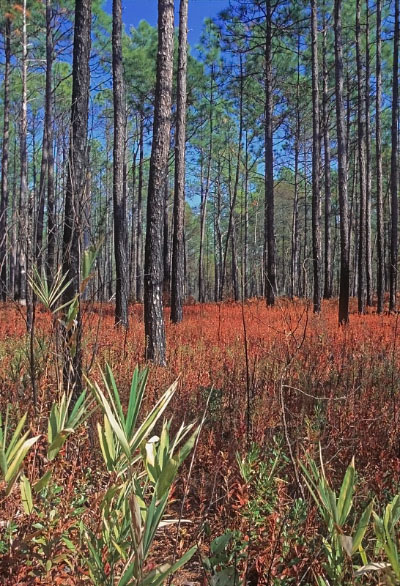

Virginia Department of Conservation and RecreationAn official website of the Commonwealth of Virginia Here's how you knowAn official websiteHere's how you know

Virginia Department of Conservation and RecreationAn official website of the Commonwealth of Virginia Here's how you knowAn official websiteHere's how you know
 Department of Conservation and Recreation
Department of Conservation and Recreation
 Table of Contents
Table of ContentsSandhill and Fluvial Terrace Woodlands
This group consists of related woodland vegetation occurring in two distinct, inner Coastal Plain habitats: on ridges (sandhills) of sandy interfluves in southeastern Virginia; and on elevated, sandy terraces bordering six rivers in southeastern and east-central Virginia.
Sand ridges of the southeastern Virginia Coastal Plain support pyrophytic mixed woodlands of pines, scrub oaks, ericaceous shrubs, and light-demanding herbaceous xerophytes. Communities in this group reach their northern range limit in Virginia, where they occur in small, highly localized patches. Similar vegetation ranges through the southeastern Coastal Plain to Texas, and was likely much more widespread in southeastern Virginia prior to European settlement. Today, remnant habitats are located primarily on slightly elevated sand deposits stretching along the eastern sides of the Blackwater and Nottoway Rivers in Sussex, Southampton, and Isle of Wight Counties and the City of Suffolk. Soils are coarse xeric sands, often overlying clay-rich subsoils that may perch water briefly and limit rooting depths. The original vegetation of these sites is presumed to have been composed of open overstories of longleaf pine (Pinus palustris), perhaps in mixtures with pond pine (Pinus serotina) and loblolly pine (Pinus taeda) at the northern end of its range, with open understories of scrub oaks (Quercus spp.), patchy ericads, and areas of open sand with sparse herbaceous cover. Stand structure and successful reproduction of longleaf pine were presumably controlled by a natural regime of frequent low-intensity fires. Extant examples have been altered by heavy cutting and decades of fire exclusion. Longleaf pine has been almost entirely replaced by loblolly pine (Pinus taeda), and most stands are now quite closed. Various combinations of turkey oak (Quercus laevis), sand post oak (Quercus margarettae), water oak (Quercus nigra), bluejack oak (Quercus incana), southern red oak (Quercus falcata), blackjack oak (Quercus marilandica var. marilandica), and sand hickory (Carya pallida) occur as overstory co-dominants and understory trees.
On the most elevated and xeric sites, frequent shrubs include poison oak (Toxicodendron pubescens), farkleberry (Vaccinium arboreum), deerberry (Vaccinium stamineum) and dwarf wax myrtle (Morella pumila). Characteristic herbaceous xerophytes, which may be almost eliminated by canopy closure and accumulations of thick leaf litter, include silvery bluestem (Andropogon ternarius), woolly three-awn grass (Aristida lanosa), hairsedges (Bulbostylis ciliatifolia and Bulbostylis coarctata), grass-like roselings (Cuthbertia graminea), spurge-nettle (Cnidoscolus stimulosus), pineland tick-trefoil (Desmodium strictum), American ipecac (Euphorbia ipecacuanhae), sundial lupine (Lupinus perennis), October-flower (Polygonella polygama), wavy-leaf noseburn (Tragia urens), and Baldwin's nailwort (Paronychia baldwinii ssp. riparia).

On sandy flats associated with the sandhills, soils may have seasonally perched water tables but are primarily well-drained and dry for substantial periods of the year. Here, the best extant fragments are dominated by mixed stands of longleaf, loblolly, and pond pines, with a scattered understory of turkey oak. Dense, mostly ericaceous shrub layers of sheep laurel (Kalmia angustifolia) or Carolina laurel (Kalmia carolina), huckleberries (Gaylussacia frondosa, Gaylussacia dumosa, and Gaylussacia baccata), staggerbush (Lyonia mariana), small black blueberry (Vaccinium tenellum), creeping blueberry (Vaccinium crassifolium), inkberry (Ilex glabra), Canadian serviceberry (Amelanchier canadensis), and switch cane (Arundinaria tecta) are characteristic. Herbs are generally sparse, but include southern bracken fern (Pteridium aquilinum ssp. pseudocaudatum), common pyxie-moss (Pyxidanthera barbulata), chaffheads (Carphephorus bellidifolius and Carphephorus tomentosus), and narrow-fruited fasciculate beaksedge (Rhynchospora distans).
Woodlands of the fluvial settings comprise a somewhat enigmatic community type occurring on flat, sandy terraces and islands along Coastal Plain rivers in eastern Virginia. These habitats are elevated well above the level of adjacent swamps and are characterized by xeric, sandy soils and open forest or woodland vegetation. Single occurrences have been documented along the Nottoway River (Sussex County); Chickahominy River, Pamunkey River and Ware Creek (New Kent County); Dragon Swamp (Middlesex County); and Mattaponi River (Caroline County). At all six sites, hickories (Carya pallida and Carya tomentosa) are the dominant trees, with drought-tolerant oaks (Quercus falcata, Quercus nigra, Quercus marilandica var. marilandica, Quercus alba) and pines (Pinus taeda, Pinus virginiana) present in smaller numbers. Shrubs occurring at all or most sites include sand post oak (Quercus margarettae), common sweetleaf (Symplocos tinctoria), American holly (Ilex opaca var. opaca), farkleberry (Vaccinium arboreum), and eastern red cedar (Juniperus virginiana). Typical herbs include sedges (Carex albicans var. australis, Carex pensylvanica, and Carex tonsa), Canada frostweed (Crocanthemum canadense), butterfly pea (Clitoria mariana var. mariana), sandhill goldenrod (Solidago tarda), and prickly-pear (Opuntia humifusa). The Dragon Run site is anomalous in the presence (despite low soil pH and base status) of several calciphiles such as eastern redbud (Cercis canadensis var. canadensis), wild columbine (Aquilegia canadensis), smooth rock cress (Boechera laevigata), robin's-plantain (Erigeron pulchellus var. pulchellus), and elm-leaved goldenrod (Solidago ulmifolia). A full understanding of the status and compositional relationships of this group will require additional inventory and assessment.
Despite past and ongoing disturbances, sandhill and fluvial terrace woodlands are important communities for conservation and restoration in Virginia because of their regional rarity. Virginia's examples of sandhill woodlands, along with those in northeastern North Carolina, lack wiregrass (Aristida stricta and Aristida beyrichiana) and other pyrophytic grasses characteristic of similar communities further south and are thus thought to represent a rare compositional variant. Stands at Blackwater Ecological Preserve (near Zuni, Isle of Wight County) and the adjacent DCR Antioch Pines Natural Area Preserve are being managed with prescribed burning, but the remaining occurrences are in critical need of protection and restoration.
References: Frost and Musselman (1987), Plocher (1999).
Click here for more photos of this ecological community group.
 © DCR-DNH, Gary P. Fleming.
© DCR-DNH, Gary P. Fleming.

 Download a spreadsheet of compositional summary statistics (Excel) for each of the community types listed below.
Download a spreadsheet of compositional summary statistics (Excel) for each of the community types listed below.

